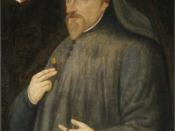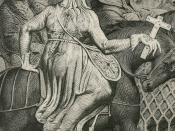Many of the religious characters in "The Canterbury Tales" represent character traits that are different from what is traditionally expected of them. This is because the Catholic Church, which ruled all of England, Ireland and most of Europe in the Fourteenth Century, was extremely wealthy. Extravagant cathedrals were built in every big city while the people suffered from poverty, disease and famine. The contrast between the wealth of the church and misery of the people was overwhelming. As a result, the characters in ChaucerÃÂs tales were portrayed as deceitful and greedy. Two examples of this are the Summoner from the ÃÂThe FriarÃÂs TaleÃÂ and Death from the ÃÂThe PardonerÃÂs Tale.ÃÂThe Summoner is a church official who brings people accused of violating church law to special courts set up by the church. This particular Summoner from ÃÂThe FriarÃÂs TaleÃÂ is a deceitful, greedy person who uses his position as a church official to pressure innocent people into giving him ÃÂbribesÃÂ or money.
He actually has a network of secret spies who report to him so that he can issue false summons and extort money from people. Instead of representing justice, he represents the exact opposite, injustice. Chaucer wrote this tale to show how greedy and corrupt church officials were during the Middle Ages.
In ÃÂThe Pardoners Tale,ÃÂ all the characters seek out Death, and the Pardoner describes Death like a person, an evil person. During the fourteenth century death was commonplace. The plague was the biggest killer of all and nobody knew what caused it therefore it was considered a mysterious and evil occurrence. In this particular tale death is personified, and all the characters in the tale who seek him out either die or kill each other when they get close to him. The point Chaucer makes...


